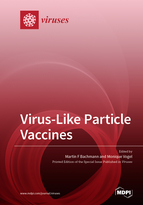Virus-Like Particle Vaccines
A special issue of Viruses (ISSN 1999-4915). This special issue belongs to the section "Viral Immunology, Vaccines, and Antivirals".
Deadline for manuscript submissions: closed (31 January 2020) | Viewed by 91381
Special Issue Editors
Interests: virus-like particles; vaccines; therapeutic vaccines; vaccines for companion animals; immune responses; memory
Special Issues, Collections and Topics in MDPI journals
Interests: allergy; immunotherapy; virus-like particles; IgE; CD23
Special Issues, Collections and Topics in MDPI journals
Special Issue Information
Dear Colleagues,
The structure, uniformity, stability, and function of virus-like particles (VLPs) have encouraged scientists to utilize them as a unique tool in various applications in biomedical fields. Their interaction with the innate immune system is of major importance for the adaptive immune response they induce. The innate immune cells and molecules recognize and interact with VLPs on the basis of two major characteristics: Size and surface geometry.
VLP-based vaccines against Hepatitis B, Human Papilloma, malaria, and hepatitis E have been developed and are available in many countries around the world. Given the inherent immunogenicity of VLPs, they render themselves ideal for the development of new vaccines against infectious diseases as well as noncommunicable diseases, such as chronic inflammation or cancer.
This Special Issue is designed to provide an up-to-date view of the latest progress in the development of VLP-based prophylactic and therapeutic vaccines and technologies for their generation.
Prof. Martin F Bachmann
Dr. Monique Vogel
Guest Editors
Manuscript Submission Information
Manuscripts should be submitted online at www.mdpi.com by registering and logging in to this website. Once you are registered, click here to go to the submission form. Manuscripts can be submitted until the deadline. All submissions that pass pre-check are peer-reviewed. Accepted papers will be published continuously in the journal (as soon as accepted) and will be listed together on the special issue website. Research articles, review articles as well as short communications are invited. For planned papers, a title and short abstract (about 100 words) can be sent to the Editorial Office for announcement on this website.
Submitted manuscripts should not have been published previously, nor be under consideration for publication elsewhere (except conference proceedings papers). All manuscripts are thoroughly refereed through a single-blind peer-review process. A guide for authors and other relevant information for submission of manuscripts is available on the Instructions for Authors page. Viruses is an international peer-reviewed open access monthly journal published by MDPI.
Please visit the Instructions for Authors page before submitting a manuscript. The Article Processing Charge (APC) for publication in this open access journal is 2600 CHF (Swiss Francs). Submitted papers should be well formatted and use good English. Authors may use MDPI's English editing service prior to publication or during author revisions.
Keywords
- virus-like-particles
- immunotherapy
- infection
- innate immune response
- therapeutic vaccines
Related Special Issue
- Virus-Like Particle Vaccines 2022 in Viruses (13 articles)








